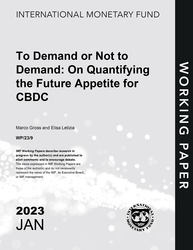
To Demand or Not to Demand: On Quantifying the Future Appetite for CBDC
To Demand or Not to Demand: On Quantifying the Future Appetite for CBDC
READ MORE...
Volume/Issue:
Volume 2023
Issue 009
Publication date: January 2023
ISBN: 9798400231018
$0.00
Add to Cart by clicking price of the language and format you'd like to purchase
Available Languages and Formats
| English |
Topics covered in this book
This title contains information about the following subjects.
Click on a subject if you would like to see other titles with the same subjects.
Banks and Banking , Economics- Macroeconomics , Money and Monetary Policy , Economics / General , Central bank digital currency , bank funding costs , central bank seigniorage , monetary policy pass-through , reinforcement learning , Authorss e-mail , bank agent , Central Bank digital currencies , Deposit rates , Central bank policy rate , Monetary base , Bank deposits , Global
Also of interest
Summary
We set up a model of banks, the central bank, the payment system, and the surrounding private sector economic environment. It is a structural, choice-theoretic model which is deeply rooted in data. We use the model to conduct a structural counterfactual that introduces a Central Bank Digital Currency (CBDC) which is optionally interest-bearing. The model can be used to provide estimates of the emerging CBDC-in-total-money shares, the drop of deposit rate spreads to policy rates, the impact on reserve needs, the implied rotation of profits away from banks toward central banks, and the extent to which monetary policy pass-through may become stronger. We obtain upper bound estimates for the CBDC-in-money shares of about 25 percent and 20 percent, respectively for the U.S. and euro area, when CBDC would be remunerated at the policy rates and be perceived as “deposit-like” by the public. Actual take-up may likely be below such upper bound estimates. The model codes—to replicate all results and to apply them to other countries—are made available along with the paper.
Copyright © 2010 - 2025
Powered by:
AIDC



